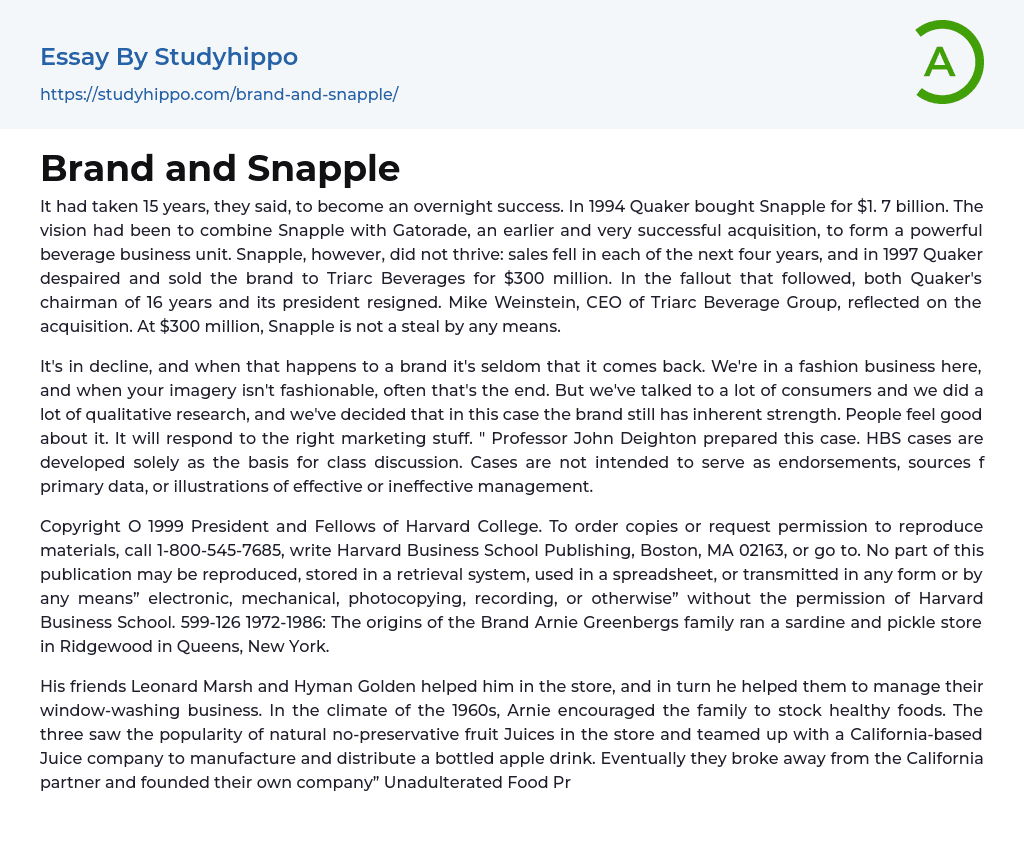It took them 15 years to achieve overnight success, according to sources. In 1994, Quaker purchased Snapple for $1.7 billion with the plan of merging it with Gatorade, a successful acquisition, to create a dominant beverage business unit. However, Snapple did not flourish and experienced declining sales in the following four years. Eventually, in 1997, Quaker sold the brand to Triarc Beverages for $300 million due to disappointment. This resulted in the resignation of Quaker's chairman of 16 years and its president, leading to a turbulent aftermath. Reflecting on the acquisition, Mike Weinstein, CEO of Triarc Beverage Group, acknowledged that $300 million is still a substantial amount for acquiring Snapple.
Despite the challenges faced in the fashion industry, the brand is currently going through a decline that can be hard to overcome. Nevertheless, extensive consumer research has reveal
...ed that the brand still possesses a strong appeal among individuals. By implementing appropriate marketing strategies, there is an opportunity for the brand to make a comeback. Professor John Deighton has created this case specifically for classroom discussions at HBS. It should be noted that HBS cases should not be considered as endorsements, primary data sources, or demonstrations of effective or ineffective management.
The content of this text is a unified andversion of the original, with the and their contents preserved.
His friends Leonard Marsh and Hyman Golden assisted him in the store, and reciprocally, he aided them in managing their window-washing business. During the 1960s era, Arnie advocated for the family to keep healthy food products in stock. The three individuals noticed the increasing popularity of natural, preservative-free fruit juices in the store and collaborate
with a Californian juice company to produce and distribute a bottled apple drink. Eventually, they separated from their California partner and established their own company named "Unadulterated Food Products," which introduced the Snapple brand. Snapple's slogan became "100% Natural."
The business expanded gradually by using funds generated internally. It opted to outsource production and product development while establishing a network of distributors throughout New York City. Whenever feasible, the business sought individual distributors who worked independently and discovered that it was necessary to diversify the product line in order to keep distributors engaged. It introduced various beverages including carbonated drinks, fruit-flavored iced teas, diet juices, seltzers, an isotonic sports drink, and even a Vitamin Supreme. While some products were successful and others were not, the profits earned from the successful products compensated for the losses incurred from the failures.
The expansion of distribution into New Jersey and Pennsylvania led to growth in revenues and profits. By 1984, annual turnover reached $4 million, and it doubled to $8 million by 1986. The founders responded to pleas from Snapple's distributors by commissioning advertising. Jonathan Bond and Richard Kirshenbaum, who later managed the Snapple account, described this early advertising as unsuccessful. Tennis star Ivan Lendl mispronounced the name "Snapple" in several ads, but fortunately, these poorly executed ads did not negatively impact the brand.
If those cheesy ads had been just a little better, they would have been even worse for Snapple. The ads' incompetence actually had a charming effect, similar to the cluttered packaging. In the 1980s, Snapple was just one of many small beverage brands trying to attract young, health-conscious urban professionals. There were numerous other
contenders in the New Age or Alternative beverage category, such as Napa Naturals, Natural Quencher, SoHo, After the Fall, Ginseng Rush, Elliot's Amazing, Old Tyme Soft Drink, Manly Sodas, Syfo, and Original New York Seltzer. During 1987-1993, known as the Glory years, many founders aimed to exit through acquisition. For instance, SoHo's founders Connie Best and Sophia Collier achieved $25 million in sales before selling their company to liquor giant Seagram in 1989 for $15 million. They believed that they were handing off to a buyer with more financial resources. Seagram expanded distribution and advertising by dismantling the independent distribution network and relying on its own wine cooler distribution chain. On the other hand, the Snapple founders decided to handle the next phase of growth by hiring professional management.
They sought the expertise of Carl Gilman, a seasoned professional in the beverage industry who previously worked at Seven-Up, to oversee sales and marketing at Snapple. Gilman utilized focus groups to gather insights on enhancing Snapple's label design. Moreover, he bolstered the advertising budget to $1 million and strengthened the independent distributor system across the East Coast.
- Alcoholic essays
- Soft Drinks essays
- Wal-Mart essays
- Discover essays
- Beef essays
- Beer essays
- Beverages essays
- Bread essays
- Burger essays
- Cake essays
- Coconut essays
- Coffee essays
- Cooking essays
- Crowd essays
- Cuisines essays
- Dairy essays
- Desserts essays
- Dinner essays
- Drink essays
- Fast Food essays
- Favorite Food essays
- Food Safety essays
- Food Security essays
- Food Waste essays
- Fruit essays
- Ginger essays
- Hamburger essays
- Ice Cream essays
- Juice essays
- Lemon essays
- Meal essays
- Meat essays
- Oreo essays
- Organic Food essays
- Pizza essays
- Rice essays
- Sainsbury essays
- Sugar essays
- Taste essays
- Tea essays
- Wine essays
- Advertisement essays
- Advertising essays
- Anheuser-busch essays
- Audience Theory essays
- Brand essays
- Brands essays
- Competitor Analysis essays
- Consumer essays
- Detergent essays




